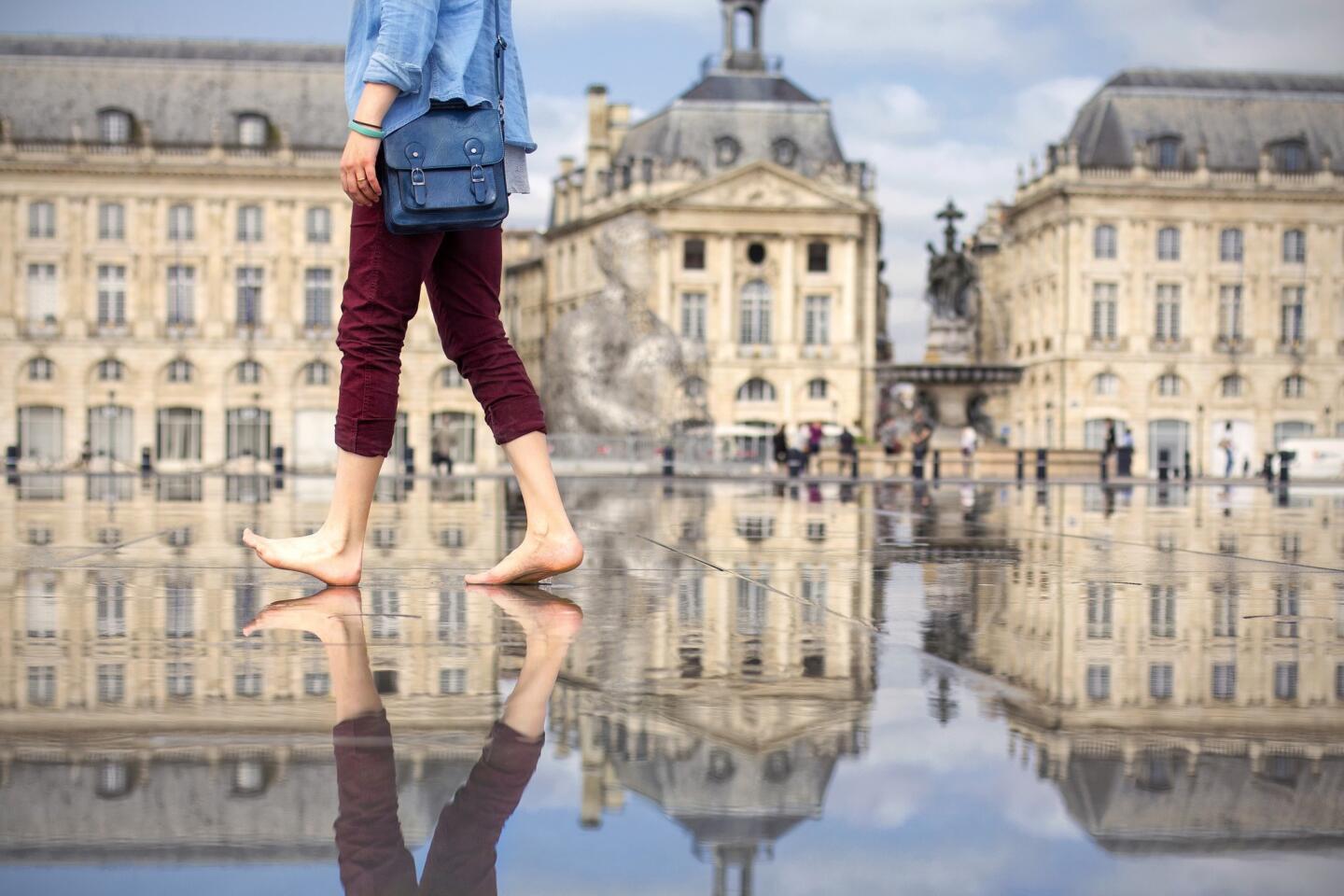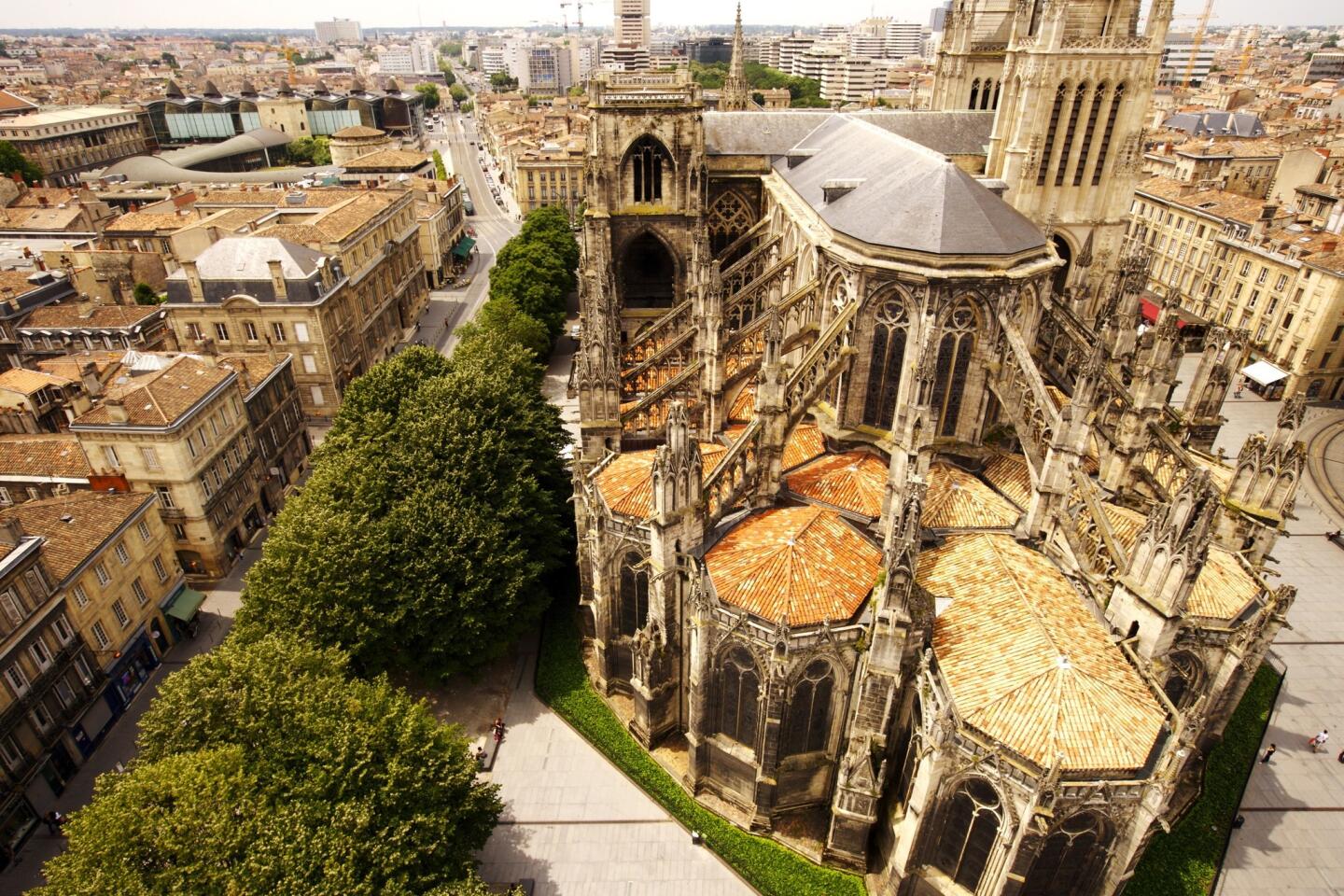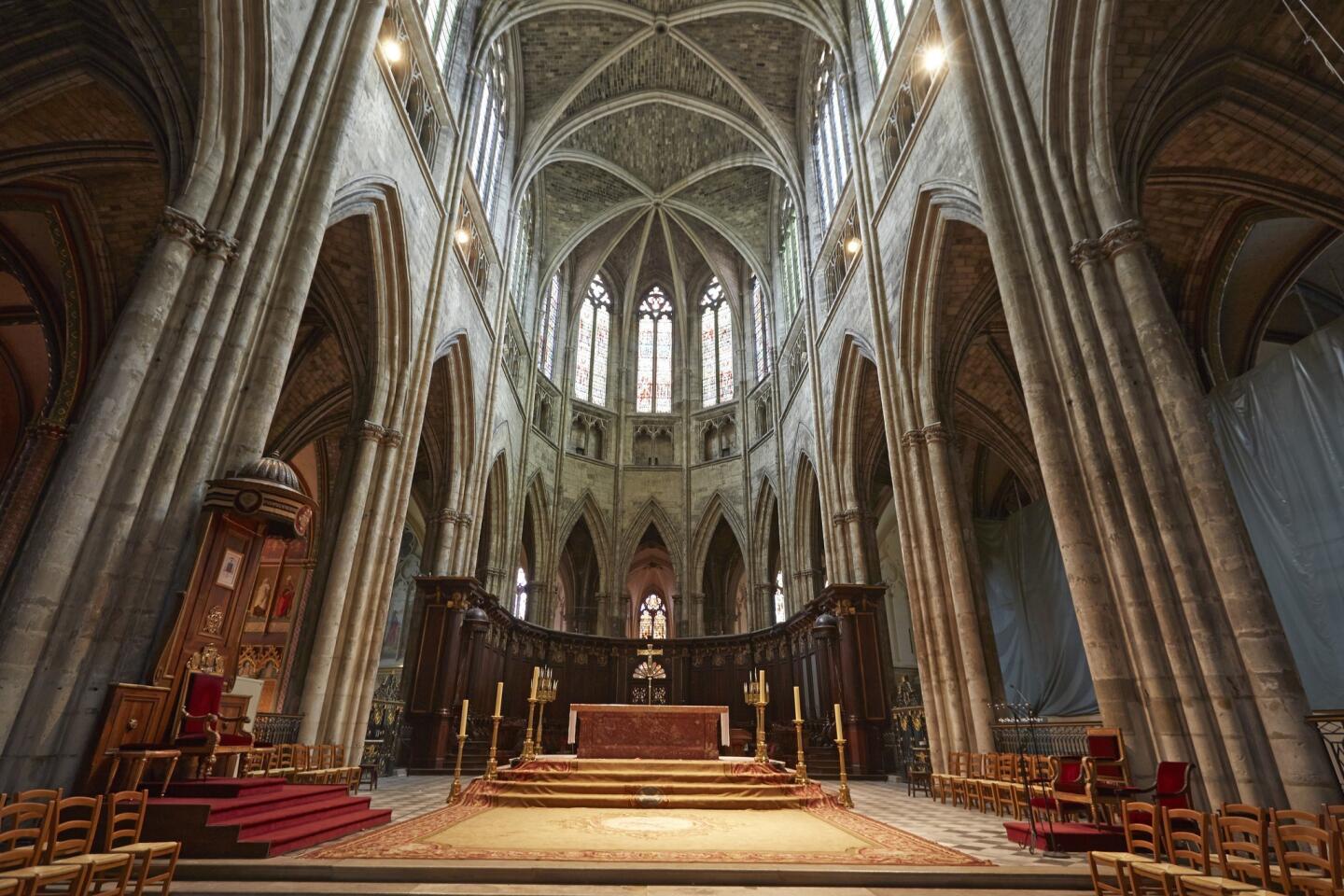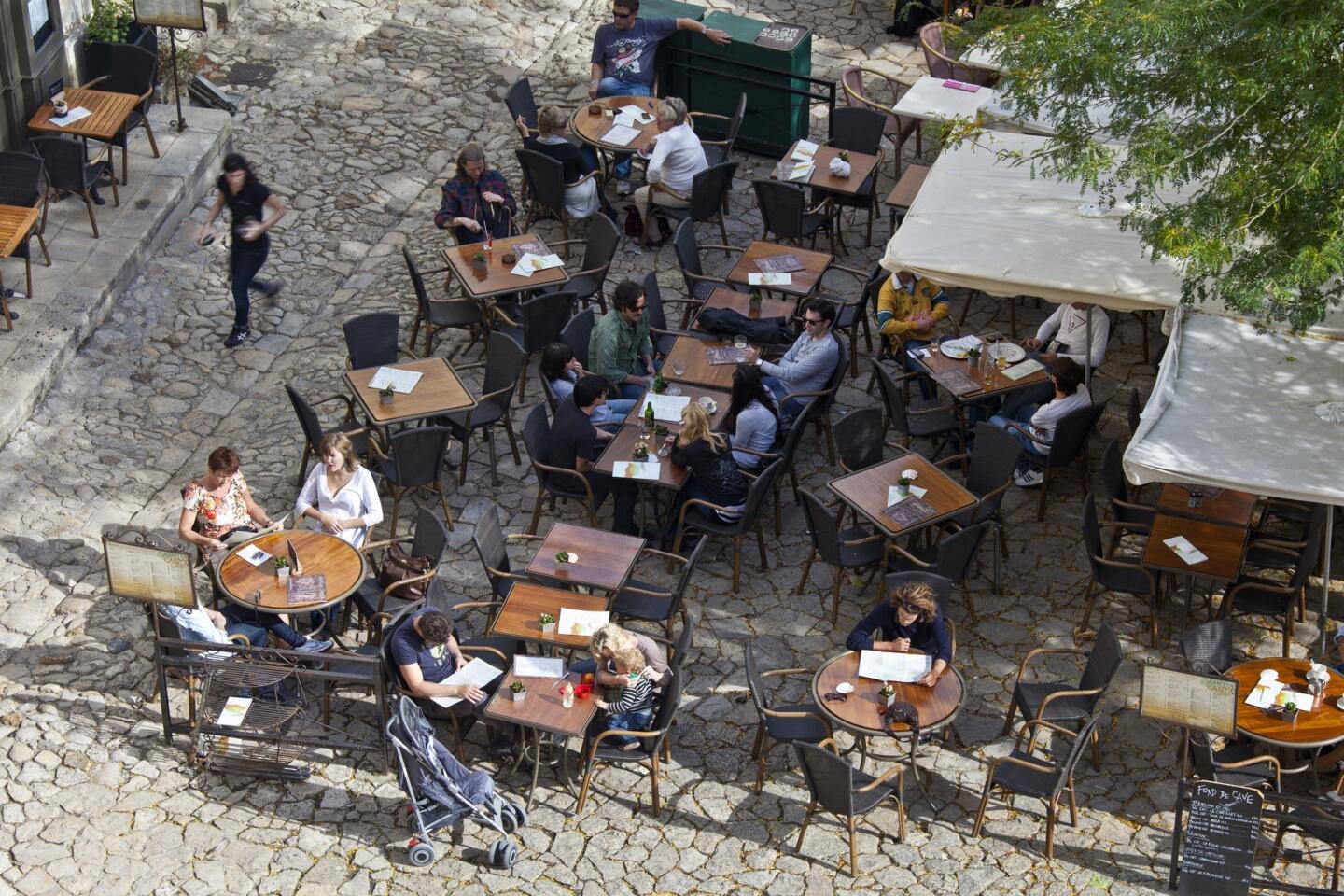Traveling to Bordeaux? The city has refined its flavor
- Share via
BORDEAUX, France — It was raining when I landed at Bordeaux’s airport, and I couldn’t find the shuttle bus. Claudia, from Santa Barbara and studying at the University of Bordeaux, came to my rescue.
How did she like living here?
“I love it,” she said. “I think it might have been dull, but in the last few years all kinds of trendy bars and cafes and boutiques have opened up, so there’s plenty to do, and in the summer they’ve made a feature out of the riverside where the old port used to be.”
Bordeaux? The port city known for wine and architecture? Had it taken a cue from sister city Los Angeles and reinvented itself?
For years, Bordeaux was known as “La Belle Endormie,” or Sleeping Beauty. Its ocher-colored limestone edifices were hidden under layers of black soot, cut off from its waterfront by derelict warehouses and rusting cranes in the old port, which had moved downriver.
Alain Juppé embarked on a major urban renewal program when he became mayor in 1995 (he now is mayor again), cleaning the historic buildings, pedestrianizing key streets, turning the old docklands into a gentrified urban frontier called Chartrons with loft apartments, boutiques and new museums, and building 27 miles of tramway to connect it together.
The results are generally agreed to have been a triumph, with half the city now a UNESCO World Heritage Site, one of the largest such urban sites in the world.
Thirty minutes after I left the airport, stepping off the bus in the spacious city center was like stepping back in time three centuries.
I took in Victor Louis’ Grand Théâtre, with its 12 neoclassical columns topped with statues representing the nine muses and three goddesses, in the middle of André Portier’s charming Allée de Tourny, a wide boulevard that is the heart of the city. I shopped in the Place des Grands Hommes with its glass-domed food and shopping mall. If you want to know where Paris got its good looks, the answer is Bordeaux, where Baron Haussmann was a prefect before he took on rebuilding the capital.
So far, so good. But I would sleep on it and see more before I signed off on the city’s transformation.
At the zinc bar of Café Tupina, I breakfasted on the local specialty, a cake called canelé flavored with rum and originally made by nuns from egg yolks and flour (the whites were used by the wine industry to clarify the wine). It made me feel like a local, but I found the canelé a little gluey and bland.
I hopped on one of Juppé’s sleek, smooth trams and almost never got off the rest of the day. It was a joy to be whisked soundlessly across the red brick Pont de Pierre, built on the orders of Napoleon Bonaparte with 17 arches, one for each letter of his name. On the far bank, the church of Sainte Marie de la Bastide looks like a thin Parisian Sacré Coeur, not surprising since Paul Abadie was the architect of both.
Through the trees, I could just see the elegant new vertical-lift Pont Chaban-Delmas. When a large ship wants to come through, it takes 11 minutes for the central section of the bridge to rise up the four tall towers to form a triumphal arched entrance into the city.
Each of my tram rides took no more than 10 minutes. At the next stop, I walked around the Cathédrale Saint-André where Gothic mixes with the Renaissance, the whole still half-cleaned and half-black. The cathedral’s interior is more cavernous than impressive, but I loved the large, square chiming clock.
Dodging heavy showers, I nipped into the Musée des Beaux-Arts (it’s free but you must have a ticket), where I found Romantic painter Eugène Delacroix’s “Greece on the Ruins of Missolonghi” underwhelming and smaller than I expected for such a monumental subject. The later collections were more interesting once I recovered from meeting a life-size dead Mozart sitting in a white marble chair, sculpted by Rinaldo Carnielo in 1877.
There are no big wows here, but there’s a lovely Berthe Morisot and a charming Mary Cassatt.
An enormous work by Alfred Smith shows “Quais de Bordeaux” in 1892 with warehouses, ships and a tram — not a Juppé tram but an old-fashioned double-decker with an open roof.
You can’t go to Bordeaux without trying wine, although my trip was too short to do the subject justice. Bordeaux was built on wine, and it remains the center of what many people still consider the world’s greatest wine-producing area, with legendary names such as Médoc and Saint-Émilion.
Don’t expect to visit the châteaux without notice. You need a little planning. Bordeaux’s tourist office (www.bordeaux-tourisme.com) is one source, among many, for wine tours, or you can take a wine cruise along the Garonne River. But if you don’t have time for that, don’t despair. Bordeaux is so proud of its production that every bar, café and restaurant in town serves premier wines by the glass. I had a Domaine La Roche 2010 Pessac-Léognan (about $9) with my duck breast on the first night in the tiled La Belle Epoque. With my salad lunch the next day at Café Andrée Putman, on top of the contemporary art museum, a Côtes de Gascogne Domaine de Joy “Eros” rose (about $5.50).
On my last evening, I couldn’t resist an Entre-Deux-Mers at L’Autre Petit Bois, a wine bar where two large trees take up more room than the tables. It was the first “grown-up” wine my father, who was in the trade, had me try. He would appreciate that you can’t get away in Bordeaux with ordering “red” or “white” but must pay attention.
After that, I was ready for my personal best of Bordeaux. I’d been saving it for last, hoping the weather would clear, and magically it did.
I headed back to Place de la Bourse, a beautiful 18th century three-sided square built for Louis XV. In 2007, landscape architect Michel Corajoud installed his miroir d’eau, or water mirror on the fourth side. The shallow “mirror” of water, as long as two Olympic swimming pools, reflects the majestic buildings until the area is slowly flooded.
When the water reaches about three-quarters of an inch deep, the reflection disappears. Then, a fine mist is released, obliterating everything and creating a cloud that everyone, including me, walks through, smiling.
Now was that a Bordeaux moment — the old, the new, the unique? Bordeaux hasn’t reinvented itself. With its rich trove of architecture and its worldwide reputation for fine wine, it didn’t need to. But it is easier to embrace than it used to be, just like a sister who had strayed a bit but has pulled herself together.
More to Read
Sign up for The Wild
We’ll help you find the best places to hike, bike and run, as well as the perfect silent spots for meditation and yoga.
You may occasionally receive promotional content from the Los Angeles Times.














